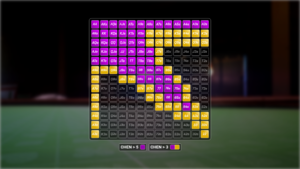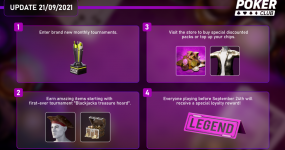What Are AI Players?
We want to ensure that you always have the heated, full-on experience of a packed table, so when needed, Poker Club uses AI players to fill any empty seats.
How Do They Work?
Each and every card in Poker Club is decided with fair RNG by the server at the time the dealer starts their animation. The primary function of the AI is to decide how their player should approach each hand, based on the cards that they are dealt. This includes everything from blind stealing, calculating odds, bet sizing, knowing when to go all in, all the way down to formulating a strategy based on their hole cards, which we are looking at today.

Hole Card Decision Making and Chen
To inform our AI’s hole card decisions we use the Chen formula, a mathematical equation for deciding the value of hands (you may be acquainted with this if you have read the in-game tutorial!) Here’s a quick guide to how that works.
- Score the highest card only. Do not add any points for the lower card.
- A = 10
- K = 8
- Q = 7
- J = 6
- 10 to 2 = ½ of card value.(e.g. a 6 would be worth 3)
2. Multiply pairs by 2 – A minimum score for a pair is 5. (e.g. KK = 16, 77 = 7, 44 = 5)
3. Add 2 points if the cards are suited.
4.Subtract points if there is a gap between the two cards.
- No gap =-0
- 1 card gap =-1
- 2 card gap =-2
- 3 card gap =-4
- 4 card gap or more =-5 (Aces are high this step, so hands like A2, A3 etc. have a 4+ gap.)
5. Add 1 point if there is a 0 or 1 card gap and both cards are lower than a Q.(e.g. JT, 75, 32 etc, this bonus point does not apply to pocket pairs)
6.Round half-point scores up.
With this in mind, we are then able to set a tight starting strategy based on seating position:
Early position (UTG)
- Raise = 9 points or more.
- Fold = 8 points or less.
Mid position (MP)
- Raise = 8 points or more.
- Fold = 7 points or less.
Late position (CO/BTN/SB/BB)
- Raise = 7 points or more.
- Fold = 6 points or less.
In terms of playable hands, this looks like this:

As you can see this is an incredibly tight opening play style, leading to very few playable hands and a lot of folded cards. If our AI only used this range to play, they would all be particularly tight ‘Rocks’ and it wouldn’t be as fun and varied as poker is in real life. So we use Chen as the building blocks and then apply different behaviours and traits to create different personalities and playing styles for the AI that represent the various playing styles of real players.
Labelling
These playing styles are called labels. They apply to players and to AI and they provide a sense of how loose or aggressive players tend to be, how frequently they call or raise, their VPIP etc. A loose player will play a broad range of hands, whereas a tight player will stick to only the strongest hands, as found in the previous Chen ranges. An aggressive player will seek to drive up the pot, whether through bluffing or with a good hand.
There are 7 labels; Calling Station, LAG, TAG, Rock, Nit, Maniac and Donkey. In future dev diaries, we’ll take a closer look at each of these labels one by one, but today we are looking at the Maniac.
The Maniac
The Maniac plays loose and aggressive, the embodiment of someone who believes that “fortune favours the bold”. They’re the kind of player that’s at risk of creating enormous tilt in their opponents, by bluffing their way to victory with a 64s.
Here’s what the range of play looks like for a Maniac pre-flop, a stark comparison to the tightly defined range from earlier:
Early position (UTG)
Raise >= 5
Call >= 3
Fold < 3
Mid position (MP)
Raise >= 4
Call >= 2
Fold < 2
Late position (CO/BTN/SB/BB)
Raise >= 3
Call >= 1
Fold < 1
Let’s take a look at what kind of range that gives them even when under the gun (UTG), their most vulnerable position:

As you can see, even in their weakest position, there’s not a lot that the Maniac doesn’t consider a viable hand, and their range for raising (in purple) is extremely wide. This means that they will often lead the pot very aggressively either pulling in a lot of chips or stealing the blinds if no one chooses to challenge them. In late position, they can be even looser with only 16 hands that they consider folding outright at Chen <1.
This accounts for Maniacs tendency to re-raise, refuse to leave pots that they invest in and seemingly over aggressive playstyle, but if you can learn their style this is something that you can use against them.
That’s it for this week’s AI Dev Diary! In the next one, we’ll be looking at bet sizing and the LAG label.
What have you learned from this first deep dive? Would you like to know more about the Poker Club AI? Join us on Discord and we will look to cover your questions as we continue our in-depth look at this complex area of the game.







